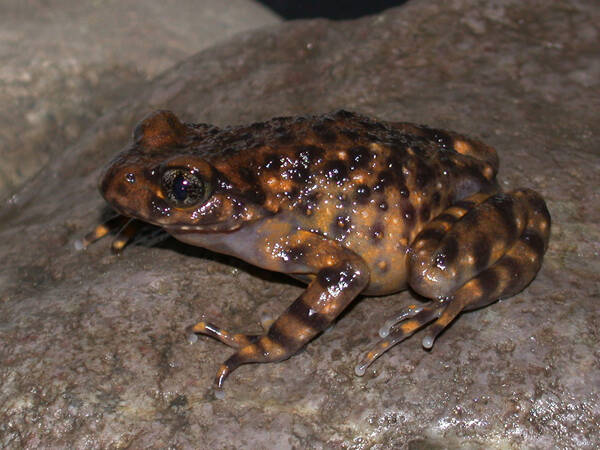Oreolalax liangbeiensis
IUCN
LCBasic Information
Scientific classification
- name:Oreolalax liangbeiensis
- Scientific Name:Oreolalax liangbeiensis,Liangbei tooth-shaped toad
- Outline:Anura
- Family:Anura Ceratophyllum Odontophorum
Vital signs
- length:47-66mm
- Weight:
- lifetime:
Feature
The warts on the head are small and flat, and the back of the body is covered with warts of different sizes, with more and denser warts towards the back. The back of the body and tail muscles are green-gray with a few dark spots.
Distribution and Habitat
Endemic to China, distributed in Sichuan (Puxiong Town, Yuexi County).
Lives in mountainous areas of coniferous and broad-leaved mixed forests at an altitude of 2850-3000m. Reproduces in May, laying 160-197 eggs, which adhere to the bottom of rocks in the stream in a ring shape.
Appearance
The warts on the back are large and dense, covered with black thorns, while the warts on the sides are sparse and have no large black thorns; the skin on the ventral side is smooth, with axillary glands and posterior thigh glands. The back of the body is light brown or dark yellow, with brown spots on the warts, and no triangular spots between the eyes; there are 3-5 brown horizontal stripes on the back of the limbs; the entire ventral side is milky white or grayish yellow, without spots.
Details
The appearance of Liangbei toothed toad is similar to that of Oreolalax major, but the hind limbs of Liangbei toothed toad are shorter, the tibia is less than half of the body length, and the left and right heels just meet; there are no spots on the ventral surface. The lip and tooth pattern of tadpoles is mostly Ⅰ:3+3 (or 4+4)/4+4:Ⅰ. The eggs are light gray in color, and the eggs are extremely milky white.
In the non-breeding season, the toad lives scattered in the forest. During the day, it hides under the rocks by the stream. When disturbed, it quickly flees to the deep water and rocks. Adult toads enter the stream to breed, the male holds the female's crotch with his forelimbs, and the female lays 160-197 eggs, which are attached to the bottom of the stone in a ring shape. Tadpoles live in the cracks of rocks in the slow flow of medium-sized streams, and their number is small.
On May 18, 1965, a pair of adult toads were found under a stone in the ditch. The male held the female's crotch with his forelimbs, but no eggs were seen. Fei Liliang and others have visited the production area for many years and determined that the spawning season of this toad can be determined to be between late May and June, and mid-June is the peak breeding period. Adult toads enter the stream to reproduce, with the male holding the female's crotch with his forelimbs. The female lays 160-197 eggs, which are attached to the bottom of the stone in a ring shape.
During the spawning season, tadpoles of the 28th to 40th stage can be seen in the lower section of the same water area. The smallest one is 54 mm in length. At the same time, those that are about to complete metamorphosis can also be seen. Some are raised indoors to become young toads, and their characteristics are the same as those of adults. This shows that the tadpoles of this toad are the overwintering type. Large tadpoles are more common on the edge of large mountain streams (water surface width 4-5 meters) or between large rocks in backwater ponds, or between rocks and cracks in small tributaries or water ponds separated from large streams. They live on the bottom and often move alone. If they are slightly disturbed during the day, they will immediately enter the deep water under the rocks. They are not easy to catch or can only be caught one by one. This tadpole was not found in the medium and small mountain streams where adult toads live, which may be related to being washed downstream by the stream water.
Liangbei toothed toad is only found in Puxiong area of Daliang Mountain, Sichuan. Its distribution area is very narrow and its number is very small. It is a rare frog resource unique to China. Due to forest fires and deforestation, the environment where the toad lives has been destroyed, making this animal resource in danger of extinction. It is recommended that relevant departments plant trees in this area to restore forests and increase this precious animal resource.
It is listed in the second level of the "List of National Key Protected Wildlife in China".








